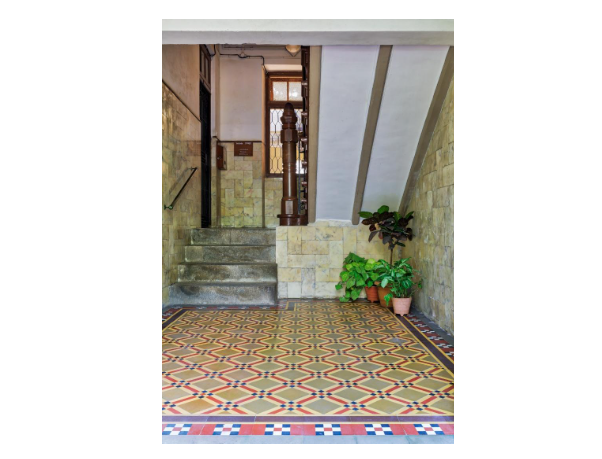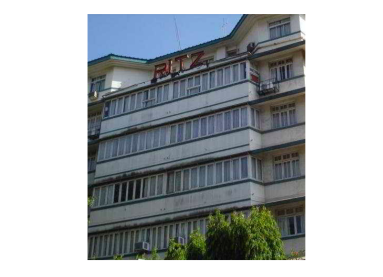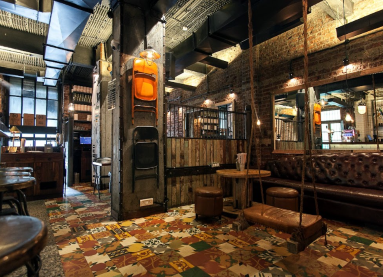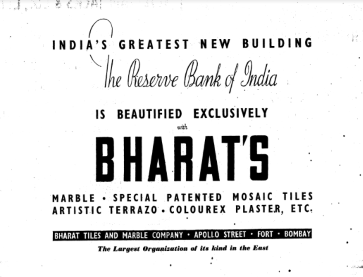100 Years
100 Stories


Pattern no. 744, seen in a staircase lobby at Brady Flats, Colaba. The cluster of 10 blocks was constructed by W.H. Brady & Co. Ltd., which commenced in 1988, BFT Archives
In 1960, one family purchased a flat in a residential complex located in the heart of Colaba in Bombay. Brady’s Flats, as it was called, ticked all the boxes for Behram Engineer’s father. A calm and friendly neighbourhood, with a house built in the style of those days, airy balconies, high ceilings, and paved with the iconic black and white star patterned Bharat tiles. His parents were happy that there was a house fit for bringing up their son and daughter, this flat which would eventually become their home for the next three generations.
An oddly elusive landmark, Brady’s Flats comprise ten cream-coloured solid stone buildings built during the British era. As far as Mr. Engineer remembers, the flats were constructed by Shapoorji Pallonji & Co. in the 1920s for an English engineering firm called W.H. Brady & Co. After the company closed down its operations in India when the British began to depart, its ownership was moved to Colaba Land Mills. In 1960, when the Land Mills went into liquidation, the residents bought flats and established a cooperative residential society.
Associated with countless memories, Brady’s Flats holds a special place in Behram Engineer’s heart. All 10 buildings in the neighbourhood are identical in proportion and design. From the fittings of the ceiling fan and the wooden console furniture to the indigenous handcrafted tiles, all are similar in all the 80 flats. Through all these years, Mr Engineer never changed the look and feel of the house. There is little to no renovation, keeping the old-world charm in line with the 100-year-old tiles and the gardens.
“Striking, colourful, and photogenic” the tiles of Brady’s Flats have been flooring people for generations. Mr Behram initially thought it was imported Italian tiles, but “to our pleasant surprise, we were told that No! These were manufactured by Bharat Tiles in India. And this was a very delightful surprise that these were Indian tiles and not foreign ones”
From the eye-catching tiles in the hallway, to black, grey and white Stars and Stripes tiles in the living room and the more subtle Diamond and Star pattern in the bedroom, these floors bear impressions of all the souls who have interacted with them. It is fun to think about all the things they have experienced or heard when his family arranged glitzy soirees on summer nights or used the floor as a playground for children. Mr. Behram still reminisces of the gatherings they used to have “We used to have several parties here. We used to play outside in the small garden attached to every building.”
Often admired for their bright yet matte colours, Bharat tiles are one of the key features in heritage buildings and residences of the Colaba neighbourhood. The tiles, says Behram, are “Very very unique. You don’t get them all over the place. Except maybe in some old buildings of the South Bombay Area.” They were also economical for their low maintenance, stamping down the notion that cement tiles are difficult to maintain. According to Mr Behram Engineer “We have not been polishing them. We just wash them with water every day. These buildings are 100 years old and the tiles are also 100 years old. I think most of the tiles are in perfect shape.”
When someone in the building floated the idea that the tiles in the entrance lobby should be changed, it was immediately shot down. Why would you want to change something which is a work of art in itself, lending personality to the building? Mr Behram still believes that “There is no need for a carpet on these tiles. These tiles are carpets by themselves. They are wonderful to be with.”
As Bombay struggles with saving heritage buildings with all elements that are unique to them, merit can be found in Behram Engineer’s firm belief in preserving the tiles and not mindlessly replacing them in the name of renovationa and modernisation. These buildings are cherished legacies for the people who have inherited them. It is only apt to preserve them so that the legacy passes on and hopefully continues to create beautiful memories for the next generation.
You may also like
-
 34The Bharat - Shapoorji Pallonji LinkShapoorji Pallonji, and Bharat Tiles went on to build some of Bombay's most iconic structures, leaving their collective mark all over the city. Explore some of the structures constructed by Shapoorji Pallonji and floored by Bharat.Read More
34The Bharat - Shapoorji Pallonji LinkShapoorji Pallonji, and Bharat Tiles went on to build some of Bombay's most iconic structures, leaving their collective mark all over the city. Explore some of the structures constructed by Shapoorji Pallonji and floored by Bharat.Read More -
 35Dine in with BharatThe ever-curious Indian palate is fueling India's burgeoning F& B segment. Sit back and enjoy this photo feature focusing on the hospitality industry pan-India and their preference for Bharat's artisanal floors.Read More
35Dine in with BharatThe ever-curious Indian palate is fueling India's burgeoning F& B segment. Sit back and enjoy this photo feature focusing on the hospitality industry pan-India and their preference for Bharat's artisanal floors.Read More -
 36Bharat and Nation BuildingPresenting to you an infographic of some of the greatest institutions and structures of modern India, whether it is educational institutions, defence academies, research centres, or financial institutions, that have been paved with Bharat's quality tiles.Read More
36Bharat and Nation BuildingPresenting to you an infographic of some of the greatest institutions and structures of modern India, whether it is educational institutions, defence academies, research centres, or financial institutions, that have been paved with Bharat's quality tiles.Read More




